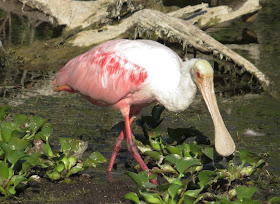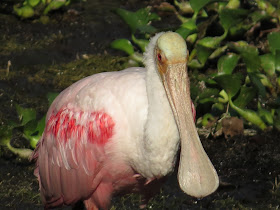Sunday April 23rd
Spring migration can be fun or frustrating for Florida Birders. It all depends of the weather conditions. So far birding activities have been slow till today. With arrival of very much needed rain and westerly winds, we're starting to see some action.
The rains also coincided with a short birding vacation I had been planning for several weeks with the idea of heading for the Florida Keys and southern Miami-Dade County for neo-tropical migrants, as well as, South Florida specialties.
So, today it's raining. But that is actually a good thing for several reasons. Mostly though, is the fact that in this end of Florida the dangers from brush fires is quite real. In fact, as I am traveling across Alligator Alley toward my destination, smoldering, smoking, blackened remnants of has been labeled the Cowbell Fire in the Big Cypress Preserve can be seen from the highway. There's a large brush fire at Merritt Island NWR their calling the Black Point Fire, and locally in 7,000 residents had to evacuate their homes in Golden Gate Estates where several homes were destroyed and fire fighters even had to help rescue a trapped rhino from a ravaged exotic animal sanctuary.. A smaller brush fire in Lehigh Acres, near Harns Marsh was quickly contained, but more property was destroyed there as well.
 |
Muscovy Ducks can been found in urban areas
through out Florida
|
Made my first stop on this trip at the Chapel Trail in Pembroke Pines. It was a quick visit, were I was able to find a trio of Gray-headed Swamphens. Usually we can easily find them at Harns Marsh, but the marsh has been drying up and the Swamphens have had to move elsewhere.
 |
| Egyptian Goose |
Then onto Kendal Baptist Hospital campus where the waterfowl didn't seem to care much about the rain. Lots of Muscovy Ducks, domestic breeds of geese and duck, a lone Egyptian Goose, a fly over of Mitred Parakeets, Common Gallinules, White Ibis, Fish Crows and House Sparrows.
Crossing over to the north side of Kendal Road, I drove around this neighborhood in search of red-whiskered bulbuls. With the rain slowing down, thought that maybe they maybe active. Didn't see any, but one feeder was hosting a trio of Yellow-chevroned Parakeets.
The rains have slowed quit a bit now as I entered the University of Miami campus in Coral Gables. This location can be a great site for exotic parrots and other avian species. In the past we have seen Scaly-headed Parrot, Spot-breasted Oriole, Red-masked Parakeet, Yellow-chevroned Parakeet, White-winged Parakeet, Chestnut-fronted Macaw and Common Hill Myna. Today I was able to add a pair of Blue and Yellow Macaws, a new bird for me, plus a single Scaly-headed Parrot and a flock of Red-masked Parakeets.
 |
| A Blue and Yellow Macaw |

 |
| Scaly-headed Parrot |
After leaving the campus it was time to check-in at the hotel in Florida City, were after supper there was still time to make a run over to Aerojet Road, outside of Everglades National Park before dark. Started with White-winged Dove and Common Mynas in town. But near to the Park I encountered a flock of Peafowl. Didn't expect that. As it was nearing dusk a number on Common Nighthawks were busy overhead and as I arrived outside at the Aerojet Road entrance to the Southern Glades Trail was met by at least ten Scissor-tailed Flycatcher, a Gray Kingbird and a pair of Western Kingbirds, one of which I suspected was a Tropical Kingbird
 |
| Common Myna |
 |
| A Peahen crossing the road |
 |
| Western Kingbird |
Best bird seen today was the Barn Owl I spotted flying across the field where the Kingbirds were found. Another noticeable observation that so many of today's sightings were exotic birds. This area hosts a great many exotic plants, reptiles, fishes and bird life. The now infamous Python invasion is another example of a very negative impact on the environment and Aerojet Road is a location that Python Hunters use locating and collecting these snakes




































